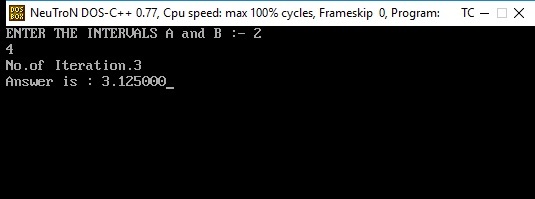Bisection Method in C
The bisection method in mathematics is a root-finding method that repeatedly bisects an interval and then selects a subinterval in which a root must lie for further processing. It is a very simple and robust method, but it is also relatively slow.
Equation: x2-10
Features of Bisection Method:
- Type – closed bracket
- No. of initial guesses – 2
- Convergence – linear
- Rate of convergence – slow but steady
- Accuracy – good
- Programming effort – easy
- Approach – middle point
Program of Bisection in C
#include<stdio.h>
#include<conio.h>
#include<math.h>
// #define f(x) x*x-10 float f(float x)
float f(float x)
{
float z;
z=x*x-10;
return z;
}
void main()
{
int count=1,n;
float a,b,m;
clrscr();
printf("ENTER THE INTERVALS A and B :- ");
xyz:
scanf("%f%f",&a,&b);
printf("No.of Iteration.");
scanf("%d",&n);
if(f(a)*f(b)<0);
{
m=(a+b)/2;
while(count<=n)
{
if(f(a)*f(m)<0)
{
b=m;
}
else
{
a=m;
}
count++;
m=(a+b)/2;
}
printf("Answer is : %f",m);
}
getch();
}
Output

